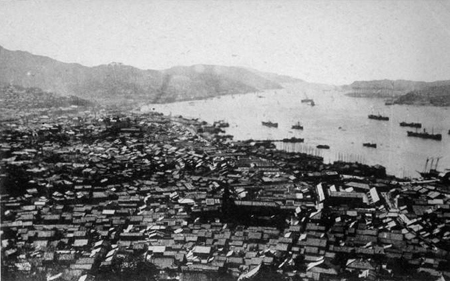

Nagasaki City
HIROSHIMA and NAGASAKI: Two Cities, One Destiny
On 8:15 A.M. on August 6, 1945, the nuclear weapon "Little Boy" was dropped on the city of Hiroshima, followed seventy-six hours later on August 9 by the detonation of the "Fat Man" nuclear bomb over Nagasaki.
In a blinding, searing flash of light, one bomber and one bomb instantly blasted the two cities to rubble. The great difference between the devastation of the two cities was a result of the different topography. Hiroshima was on a low flat delta interlaced by seven tributary rivers; Nagasaki was divided by a mountain spur into two distinct valleys.
In Hiroshima, the bomb exploded over the center of the city, destroying everything in a one-mile radius. In Nagasaki, the bomb was detonated in an industrial valley flanked by a mountain spur so that the total destruction took place within a half a mile that shielded the major business and residential districts. Yet the more powerful Nagasaki bomb of 20 kiloton (TNT equivalent) compared to the 15 kiloton Hiroshima bomb caused a far greater radius of damage than in Hiroshima.
The Human Toll
The nature of an atomic explosion explains the magnitude of the human casualties in the immediate and delayed aftermath. A measure of the enormity of the energy released by atomic weapons is that the light of the bomb in brightness is comparable to the sun, and the temperatures and pressure are comparable to those in the sun’s interior. The light rays consist of thermal radiation that burns the cities and bodies and nuclear radiation that penetrates the body.
In the immediate aftermath, a quarter to a third of the population was killed by burns, trauma or radiation, or by a combination of these. The principal delayed effects of radiation concern the development of cancer, especially among those exposed in early childhood compared to adults; the brain damage to the fetus born to mothers exposed to the atomic bomb; and the genetic effects to the children born to the survivors.
Children of the Atomic Bomb Survivors Today
Seventy thousand new-borns were examined in Hiroshima and Nagasaki. In Nagasaki, 500-800 babies were examined in their homes. No evidence of genetic injuries were detected at that time. But today, in 2008, new studies done on survivors and their offspring are revealing conclusive DNA genetic changes and malformations. These studies utilize newer modalities to detect DNA injuries. The children of survivors, now adults, are concerned how genetic damage from the bomb may be transmitted to their children through generations.
Aside from the physical injury and radiation the most significant effect of the atomic bomb was the sheer terror which it struck into the citizens of these bombed cities. Such terror, unprecedented in humankind, was etched forever onto the bodies and minds of the persons who experienced it.
The tragedy of Hiroshima and Nagasaki is not just Japan’s, but it is the world’s. Therefore, it is the responsibility of all nations to prevent another nuclear disaster for the safety and well-being of all our children.